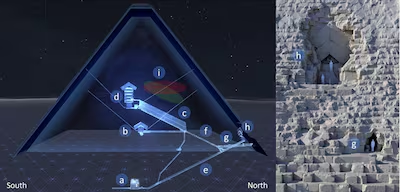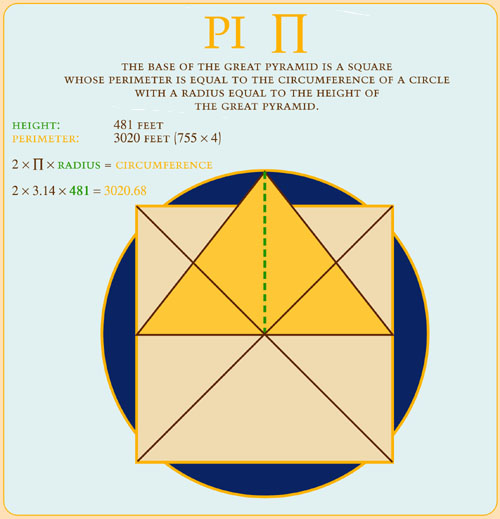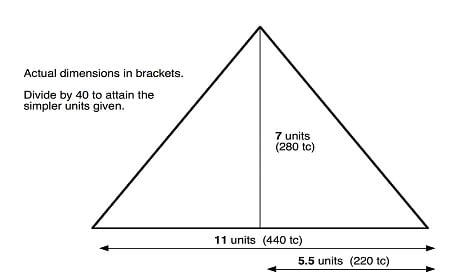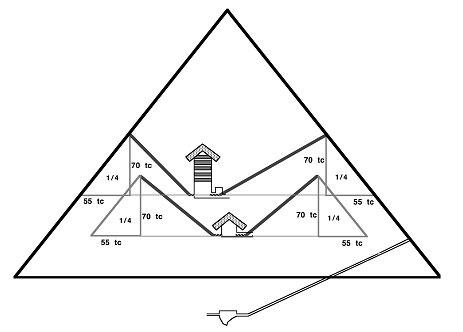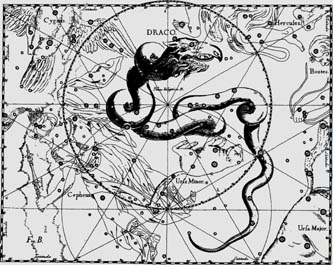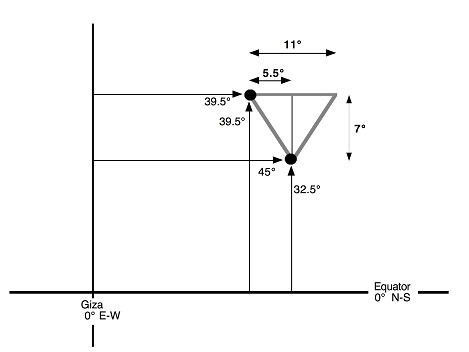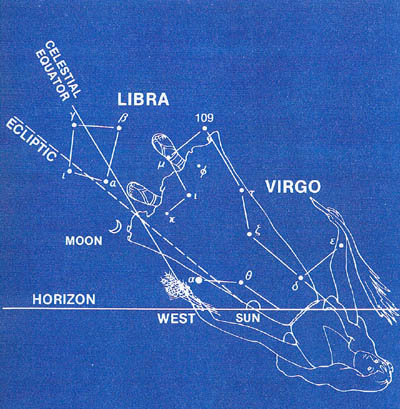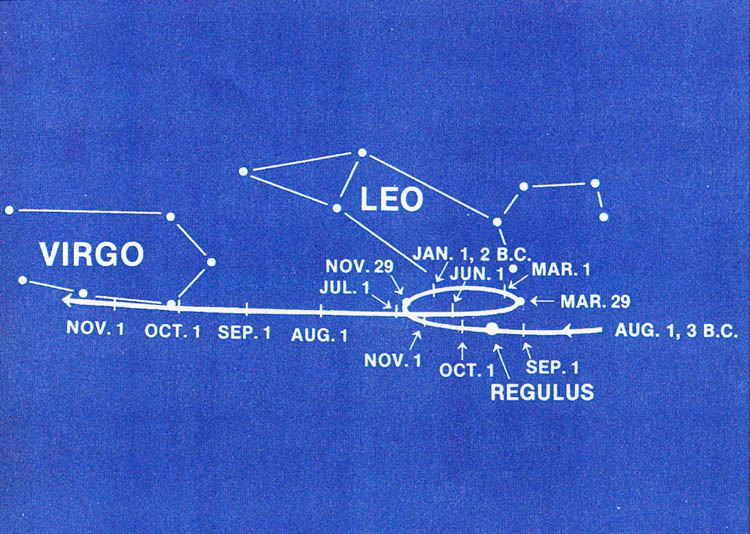Welcome to our April 2024 Blog! This month we are featuring the class Syllabus notes for the first two segments of the Celestial Gospel Seminar that was run by Rev. Jon Nessle and myself in Mahwah New Jersey. What a great Day in the Word we enjoyed with all the Northeast believers, this month graciously hosted by PK Krywos of the Christian Family Fellowship of New Jersey Believers. The class Syllabus notes for Segment 3-the concluding session are found in the June 21′ blog. The entire class will be available online shortly for your edification and enjoyment!

Old Covenant Foundations of the Celestial Gospel
There is an existing debate over the validity of a Celestial Gospel over the years, the term referring to what E.W. Bullinger called the “Witness of the Stars” in his popular book on the subject, published in 1893. A Bullinger contemporary was Dr. Joseph Seiss, who published “The Gospel in the Stars,” a decade earlier in 1882. These two resources provided a foundation for study in this important area of research, as they built on earlier work of Frances Rolleston who published her work in the book; The Mazzaroth, or the Constellations in 1865. E.W. Bullinger credits Rolleston for her research as the first to generate interest in this key but, misunderstood topic.
Although F. Rolleston was the first among more modern writers to advocate the Celestial Gospel, that does not mean that there are no ancient texts that support or attest to the Gospel in the Stars. For the most part, we need only consult the Biblical Text for all the needed proof, since God always protects
the integrity of His Word, whether Spoken, Written in the Stars, or written in
Scripture. A goal of this research is to provide a solid Biblical and spiritual foundation for The Gospel in the Stars, which as a specific topic of study has remained a bit cloudy and ill–defined in certain categories up to now. Since the cornerstone of the Celestial Gospel foundations are found in holy Scripture, they provide the spiritual principles upon which the Star Gospel is based, but they are
by no means the only historical evidence supporting these foundations. There is a rich astro-archaeological history of ancient cultures like Egypt, India, Persia, not to mention ancient Israel naming a few, whose testimonies added their voices to support of the meanings and concepts of the star names of the Celestial Gospel.
Although the monumental works of Rolleston, Bullinger, Seiss and others did provide a basis to understand the idea of the Celestial Gospel, their works did not fully disclose the OT Covenant foundations of the Celestial Gospel in God’s Word. Thus, lacking the full Biblical basis for the Celestial Gospel, it is critics like Faulkner, who have attempted to exploit this blindspot to discredit the idea of The Celestial Gospel, that demands a response to shine a positive spotlight on this key topic. This is a focus of our current study. In context of Jon Nessle’s OT History Class, an overarching framework of God’s OT Covenants initiated by God to Man were established, starting with Adam and Seth, and included Noah, Abraham, Moses, David and the prophets, completed in the Promised Seed-Jesus Christ. This was generally accomplished in previous teachings in our seminar on the Celestial Gospel of the OT History Class. Today we will expand on the basis of these teachings, providing added key details to the truths we first presented two years ago.
In a recent critique of the writings of Frances Rolleston and the idea of the “Gospel in the Stars,” that she popularized c. mid-1800’s, [Dr. Faulkner-2013] states;
“Not only are there no texts preserving the original knowledge of the gospel in the stars, but we know of no sources before Rolleston that claimed that there ever were such texts, or that any ever lived who believed such things. The first source we know of to make this claim is Frances Rolleston’s book. Let me be clear—it is obvious from Rolleston’s book that she had no texts that clearly taught her thesis. Instead, she created the meanings to support her thesis without reliance upon any older texts. The evidence we have that is most consistent with the Gospel in the stars thesis not being an ancient idea at all, but entirely the invention of Frances Rolleston less than 200 years ago.”#1
To begin our response to Dr. Faulkner’s assertion that the idea of “the Gospel in the Stars thesis not being an ancient idea at all,” we will open with evidence to first counter Faulkner related to the Great Sphinx.
Figure 1. The Great Sphinx
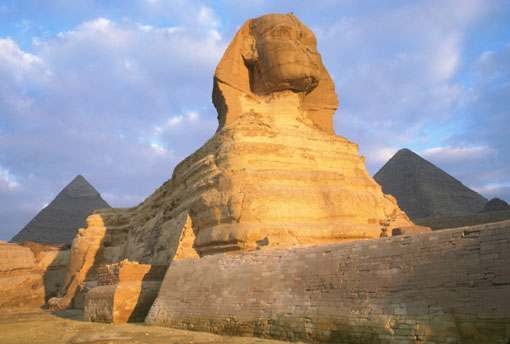
In the ancient Egyptian language, one later derivation of the word “Sphinx” is found in the Egyptian “shesep ankh,” meaning a living image. However, instead of the living idol images of idol gods or pharaohs, a proposal of this study is that the Great Sphinx was originally intended as an oracle of the Promised Seed and the Messiah. Both Lockyer and Rolleston state, that a function of the Great Sphinx symbolized the summer Solstice 4000 years before Christ, sealed by the union of the constellations Virgo and Leo. The name “Sphinx” in the ancient dialects means “the pouring out” as in [Deut. 33:19] relating to the creation of the world, the inundation and the summer solstice, where the Nile begins to rise. Deut. 33:19 translates the inundation of the Nile as ‘abundance’ in the blessing of Zebulon who bore Virgo upon his standard.”#2 There exists a tradition that the Creation took place at the summer solstice. This view of the figure of the Great Sphinx was seen as the junction of the signs Virgo and Leo, marked by the star Denebola–a star name meaning “the Lord comes quickly.” 3#
The Riddle of the Sphinx attests to the Sun’s solar circuit on the ecliptic [Ps. 19:1] that marks the starting point of where to begin reading the first chapter of the wondrous heavenly scroll of the Celestial Gospel. Another meaning of the word “Sphinx” is to “bind closely together” and this design of the junction of the signs of the Virgo and Leo constellations, shows the two ends of the Mazzaroth to be joined in a renown mythical union of the greatest and oldest Sculpture on our Planet. The union of the head of the woman-Virgo with the body of Leo the Lion, the Great Sphinx is a constant reminder from ancient Egypt, to begin our deciphering of the circular witness of The Celestial Gospel in Virgo that concludes in Leo. This ancient and great monument thus not only preserves the canon of God’s Word engraved in the heavens but also this fusion of alpha/omega signs in Scripture are inseparably linked for all time, written in the stars. As Enoch Prophesied of the Promised Seed [Jude 1:14] before this witness was ever committed to holy Writ of Scripture, [Ps. 19:1-4], so his witness is a doctrinal pillar to support the Celestial Gospel. This heavenly witness has been continuously rehearsing the truths of the Creator’s handiwork to all ancient cultures of the created earth, as God established a tabernacle for the Sun in the 12 constellations and signs of the Mazzaroth, on the Zodiacal Band and the ecliptic, [Rev. 12:1-2].
Rolleston notes that this junction of Virgo and Leo, marked by the star Denebola, a name meaning “the Lord or Judge who comes quickly,” thus embodies the living image, of the Lord Jesus Christ coming in judgment. As the star marking the link between Virgo and Leo, the prophetic message of the alpha and omega signs of the Biblical zodiac, the celestial image of the coming Messiah has endured in the largest, oldest and most renown sculpture on the planet-The Great Sphinx.
The Mystery of the Sphinx and the Celestial Gospel
Scriptural references and ancient sources demonstrate that God called the constellations by their names, opening with Virgo and ending with Leo, and their order is divinely orchestrated, forming the ancient basis of the Gospel in the Stars. The Almighty has ensured the preservation of His Gospel in the Stars not only in the 100+ individual ancient Hebrew star names, many preserved in Hebrew Scriptures, but also with 425+ star names from all ancient languages, including ancient Egypt that documents the themes taught by each of the 12 constellations, supported by their decans.
Ps. 147:4-5 4 He telleth [H] the number of the stars; He calleth [H] them all by their names. 5 Great is our Lord, and of great power: His understanding is infinite. [See also Isa. 40:22-26]
The Scriptures are God’s Revealed Word and absolute standard for truth, and the oldest book in Scriptural canon is the Book of Job, that contains more ancient direct astronomical references to star names than any other. Some of the same words that God uses as star names also occur in other Scriptural contexts, from which we can glean added depth to the truth evident in both Gospels written in the stars and Scripture. The truth that God Himself numbered and named the Stars, shows the weight and emphasis He puts on His Celestial Gospel, [Isa. 55: 8-13]. God did not leave the integrity of the truth of His Word in the hands of men, for any aspect of His Word, endorsing the integrity of both Scripture and the Gospel in the Stars under the exclusive authority of God Almighty alone. We find this depicted as the Almighty questions Job, regarding Who has control over the Heavens.
Job 38:31-33 31 Canst thou bind the sweet influences of Pleiades, or loose the bands of Orion? 32 Canst thou bring forth Mazzaroth in his season? or canst thou guide Arcturus with his sons?33 Knowest thou the ordinances of heaven? Canst thou set the dominion thereof in the earth?
It is the witness of Scripture alone that supports the validity of the Celestial Gospel, to stand or fall on the merit of these Godly Covenants, as the word of the Almighty requires no assistance from secular sources, the ordinances of heaven. But this does not mean there is a lack of secular evidence in support of the Celestial Gospel, including archaeological history from ancient Egypt that appears on this link, to my blog in April, 2020. This study is part of a series of rebuttals against Dr. Faulkner’s critique of Frances Rolleston’s writings on The Mazzaroth, along with the works of Dr. Bullinger and Dr. Seiss.
To understand the roots of the Celestial Gospel, we must first comprehend God’s Creation of the Heavens and Earth, and His Covenant’s with Man, beginning in Genesis. The Stars, Sun and Moon were not created till the 4th day of Creation Week. These lights in the firmament were organized, to divide the day from the night, and for signs, seasons, days and years, as the Sun, Moon and Stars move in their pre–ordained courses on the ecliptic, set in synchronized motion by the Hand of The Almighty, in the beginning. [Gen. 1:14-19, Ps. 19, Isa. 40:22-26]
Faulkner admits that; “Gen. 1:14 records that one of the purposes of the heavenly bodies is for man to mark the passage of time (seasons, days, and years), which has always been a function of astronomy. As the first man, Adam was in place to establish astronomy, in its calendrical function, thus Faulkner has no quarrel with this aspect of the stellar witness of the heavens, that has been a given in the scientific community going back to many ancient cultures like Egypt and Greece, also agreed by Josephus.” #4
As we proceed in this study, we will see how Adam’s position as the first man in establishing astronomy and timekeeping based on astronomical calendars, is a key aspect of the narrative providing a foundation for the Celestial Gospel, established with Noah’s Covenant, that cannot be ignored. We will also see that the Celestial Gospel includes key topics in astronomy both vital and central to the History of Astronomy, forming a basis at the origins of Astronomy as an aspect of Scientific inquiry. An example of this is the conception of the 12 constellations on the ecliptic as a unit. Another related concept is that of The Zodiacal Band, found documented below. Both of these concepts are included in the Celestial monument of the Great Sphinx, as seen in the oldest book of Biblical Canon, the book of Job;
Job 19:23-25
23 Oh that my words were now written! oh that they were printed in a book!
24 That they were graven with an iron pen and lead in the rock forever! 25 For I know that my redeemer liveth, and that he shall stand at the latter day upon the earth:
These verses were not only indicative of Job’s knowledge of his coming redeemer, but also of his faith that this redeemer would stand at a future latter day upon the earth. This knowledge directly corresponds both, with a witness that was engraved in the rock forever, remaining unto our day, and in agreement with the witnesses of the celestial and written gospels. The word “For,” beginning verse 25, grammatically depicts the purpose of his words along with a monumental witness in stone, whose longevity still stands in our day, as a witness to the redeemer that Job foresaw so long ago. Thus, Job’s reference in this majestic declaration of his redeemer, graven in rock forever, is readily linked with this enduring memorial on the Giza plateau, analogous with the prophecy written in the stars, as a unit between Leo and Virgo, in the Celestial Gospel, memorialized in the Great Sphinx.
In the only book of the Bible, exclusively addressed to the Patriarchal Age, Job’s stone-cut words ring out from the earth’s most massive and ancient hand carved sculpture, as a witness of the stars, testifying to observe, what God provided not only to Biblical Patriarchs in the Bible’s first book written by Job, but in
unique concert with the Celestial Gospel that predated the written Scriptures, engraved in the heavens as a precursor of the first book of God’s sacred text, in Genesis 15. Here God records His Covenant with Abraham, telling him to look to the stars, to see if he could number them, adding “so shall thy seed be.” The very idea that God recorded His Covenant with Abraham in the stars of the Celestial Tapestries, linked the perpetual nature of His Covenant with the 12 tribes of Israel to the fixed stars, in steadfast permanence, that furnished evidence in the 12 constellations of the Heavens; as a multi-media affirmation of His truth, the enduring witness and everlasting Word of the Almighty Creator.
As we have seen in previous blogs the origin and purpose of the Great Sphinx is rooted in astronomy. The stellar function of the Great Sphinx is augmented by the role of the Sphinx as a sighting device, tying directly to its astronomical functions, in this case to observe and record the horizon points of the sunrise, as documented by Moses Cotsworth.#5 This aspect of the Sphinx shines new light on its astronomical origins related to the Dendera Zodiac, from it’s Temple in Esneh, Egypt. From the hieroglyphs on this ancient Egyptian Zodiac we find a representation of the basic celestial elements of the Great Sphinx broken down in Figure 2 below.
Figure 2. Inset graphic of Virgo and Leo originating the basis for the Great Sphinx in its original Celestial Context.#6

The inset graphic on the Dendera Zodiac above is from Egypt’s Esneh Temple, where an image of a Sphinx was put between the signs for Leo (on the lower left) and Virgo (on the right, holding a branch). The word sphinx means “to bind closely together” (from Greek-Sphiggo), depicting the point where the Mazzaroth/ 12 constellations begin and end. And, like the female head of the Sphinx, the constellations begin with Virgo, and end in the Sphinx’s lion tail, with Leo. This reveals an astronomical purpose of the alpha-omega signs on the ecliptic, denoting the inception point of where to begin reading the witness of the stars as they relate the circular message of the coming King and redeemer-Jesus Christ, on the ecliptic. This divine order of the Mazzaroth, is preserved in the Sphinx, as an exhibit in a Megalithic Museum of archaeo-astronomy structures on the Giza Plateau-with the Pyramids, and the Great Sphinx unlocking age-old mysteries of the zodiac, consistent with the themes of the Gospel in the Stars, taught by men of God like Enoch, and Seth; as great examples of Patriarchs of the Bible, before the tenets of Scripture were fully committed to writing. This notion is supported by ancient traditions in Egyptian and Bible History, where Enoch held a key place as the embodiment of Thoth-the god of wisdom, and as the divine scribe–recorded the King’s deeds in his reign. The semblance between Enoch and Thoth/Hermes, is evident as both were revered pertaining to the invention of writing and sacred books. With shared celestial roots, Hermes ostensibly recorded 36,525 books and lived 365.25 years, so Enoch also lived 365 years, [Gen. 5:23] to match the number of days in a solar, and Egyptian Sothic year. This stands out in the genealogy of Bible Patriarchs as an anomaly, as all of Enoch’s relatives- in a line of Bible Patriarchs had life spans exceeding 895 years-except Lamech who lived 777 years; in excess of twice Enoch’s lifespan. In later Judeo-Christian lore, from Josephus, offspring of Seth including Enoch, was credited with planning and building two pillars, one of stone linking to the Great Pyramid of Giza, and the other, likely the Great Sphinx, were both encoded with prophetic wisdom “in the Siriadic land,” referring to Egypt, the land of Sirius, before the flood. [see the “pillar” of Isa. 19:19]#7
In reference to a key astronomical function of the Great Sphinx, in its Pre-dynastic stellar role as a sighting device, one astronomical aim was to watch and record the horizon points of the sunrise, seen not only in the Great Sphinx’ orientation facing due east, but also to mark the tropics of Capricorn & Cancer.
The Great Sphinx
The Sphinx’s solar alignments related to earth’s tropical borders, depicted ancient knowledge of the Zodiacal band, within which the heavenly bodies and stars named by God the Creator [Ps. 147:4, Gen. 37:9-11, Isa. 40:26, Job 9:7], shed their 3-fold light upon the Earth. God set the tropics of Cancer and Capricorn, as celestial boundaries wherein the Sun, Moon and Planets all move, above and below the celestial Equator. God created all the stars and numbered these celestial bodies, but He did not name them all without exception. Thus, the stars within the Zodiacal Band-God marked to carry His message in The Celestial Gospel, and His eternal plan to redeem mankind. There have been few to realize the key role of the Great Sphinx as the Alpha/Omega signs in the the circle of the Celestial Gospel, but I have not seen it referenced as an early symbol of the Zodiacal Band anywhere else. We find added biblical evidence of this in Joseph’s 2nd dream, [Gen. 37:9-11], in its astronomical context.
Gen. 37:9-11 9 And he dreamed yet another dream, and told it his brethren, and said, Behold, I have dreamed a dream more; and, behold, the sun and the moon and the eleven stars made obeisance to me. 10 And he told it to his father, and to his brethren: and his father rebuked him, and said unto him, What is this dream that thou hast dreamed? Shall I and thy mother and thy brethren indeed come to bow down ourselves to thee to the earth? 11 And his brethren envied him; but his father observed the saying.
The Zodiacal Band of 12 primary Constellations and their stars.

In Joseph’s second dream, we find evidence not only of the knowledge of the Zodiacal band with the Biblical Patriarchs, since Joseph’s 11 brothers appear as 11 stars, with Joseph as the 12th constellation, summarizing the primary signs found along the paths of the Sun and Moon, embodied in Joseph’s parents. We also see evidence of the ancient knowledge of the Precession of the Equinoxes, wrapped up in the idea that “the eleven stars made obeisance to me.” This idea that the other 11 Constellations of the ecliptic, bowed down, prostrated them-selves to Joseph’s sign/star, exhibits a figurative idea of precession, expanded upon in the link above. This ancient knowledge of the zodiacal band with the Bible Patriarchs, is added astronomical proof, and key aspect of the Celestial Gospel in concert with Scripture, astronomy and the Great Sphinx; the head of the woman-Virgo unified with the body of the Lion-Leo, as a stellar prophecy of the promised seed in the birth of Christ.
We also find the perfection of divine order in the number 10 related to the genealogy of Biblical Patriarchs, and the legacy of God’s Covenants with man, where not only Noah was counted as the 10th generation from Adam, [Gen. 5:1-32], but also in Abraham as the 10th generation from Shem, son of Noah [Gen. 11:10-26]. Thus all Earth’s inhabitants, were saved in Noah’s seed, as the focus of God’s singular purpose to redeem and save sinful man from every tribe, tongue, nation, and race, through the blood of our Lord Jesus Christ, [Gen. 3: 15]. This reveals God’s purpose, as developed in a further series of Covenants building from Noah to Abraham and his seed, providing both a temporal and spiritual context of how God Almighty not only repaired these Ages or spiritual dispensations, but also progressively revealed His eternal purposes in Christ.
Contrary to Faulkner, Dispensationalism presents a framework to interpret Scripture as it lays out successive periods of redemptive history where God progressively revealed more and more about His plan of redemption. This corresponds to [Heb. 11:3] “the worlds [aion-ages and time periods] or each of the ages [dispensations] were framed by the word of God… This also exposes Faulkner’s falsehood that God would reveal His entire redemption plan to the first Adam.
As we build the case for The Celestial Gospel in Scripture, an added key aspect of this narrative involves the astronomical subject matter of the ancient prophets in harmony with the application of their star prophecies. In the oracle of Balaam in [Num. 24:8] below as he beholds the glory of Israel’s wilderness encampment, and he identifies three of the four tribes at the cardinal points of the compass; Aquarius in verse 7, emptying his water buckets into the Southern fish–Pisces Australis, with Taurus the wild Ox in verse 8, and Leo the Lion in Num. 24:9. Num. 24:8 documents how God brings the 12 tribes coming from Joseph and his 11 brothers out of Egypt, in summary by referencing three of the “corner-stone tribes” of Israel that embodied the constellations of Aquarius, Leo and Taurus. These royal constellations of Israel provide us the anchor points of the 4 key tribes at the foundational sides of Israel’s wilderness camp, later carried over to the structure of the city plan of Jerusalem itself.
iii. Balaam’s Prophecy. This imagery from the prophecy of Balaam spoke of the destiny of Israel. He mentions that Israel “shall pour water out of his buckets” (Reuben/Water Bearer), “he lay down as a lion” (Judah/ Lion), and he has “the strength of a unicorn” (Joseph/Bull), and shall “break their bones” as does either an eagle or constrictor serpent (Dan; Num. 24:7-9). This attests to the fact that the Northern tribe of Dan was omitted from this list of the 12 tribes because they introduced the forbidden practice of idolatry to Israel, and were replaced by the Eagle/Aquila. The idea that again all four figures correspond to the cornerstone symbolism indicates that this prophecy refers to constellations linked to these 12 tribes. For instance, ancient stellar history shows the signs of Taurus (the bull) and Orion, in cave art of Lascaux, in France, dating back to 3000-2900 B.C.
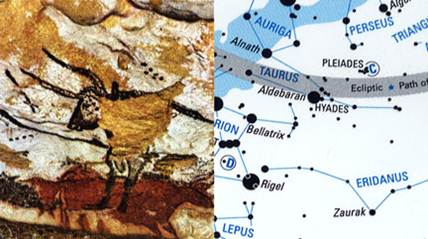
For those who do not think there is any reference to the stars in the picture of the bull above, please note the series of dots above his back. These are the Pleiades. The dots under the eye of the bull are the Hyades, and the four dots to the left of the bull’s nose are the stars in Orion’s belt. There is really no avoiding this identification. #8
The book of Job is the earliest completed book of the Old Testament, written circa 2900 B.C. In Job 38:31-32, the Pleiades and Orion are both mentioned by name, and linked closely with Taurus.
Num. 24:2-9 [ESV]
2 And Balaam lifted up his eyes and saw Israel camping tribe by tribe. And the Spirit of God came upon him, 3 and he took up his discourse and said, “The oracle of Balaam the son of Beor, the oracle of the man whose eye is opened,[a] 4 the oracle of him who hears the words of God, who sees the vision of the Almighty, falling down with his eyes uncovered: 5 How lovely are your tents, O Jacob, your encampments, O Israel! 6 Like palm groves[b] that stretch afar, like gardens beside a river, like aloes that the Lord has planted, like cedar trees beside the waters. 7 Water shall flow from his buckets, and his seed shall be in many waters; his king shall be higher than Agag, and his kingdom shall be exalted.
8 God brings him out of Egypt and is for him like the horns of the wild ox; he shall eat up the nations, his adversaries, and shall break their bone in pieces and pierce them through with his arrows. 9 He crouched, he lay down like a lion and like a lioness; who will rouse him up? Blessed are those who bless you, and cursed are those who curse you.”
The cycles of the Sun and Moon bowing down to Taurus from Joseph’s dream [Gen. 37:9-11], tells us that the precessional Age of Taurus is indicated, which is consistent with the cardinal constellations pointed out in Numbers 23-24, that detail the precessional markers or cardinal points for this age. This precessional knowledge filtered through ancient Egypt and was applied along with the Sothic Calendar, during the Age of Taurus, documented by many archaeo-astronomers. #9 Even as Abraham is recorded in history among the first teachers of the ancient Egyptians, there were others like Enoch and Shem before him. As Jacob’s grand-father, Abraham also schooled Jacob in the tenets of the Patriarchal Academy of Astronomy.
This exerted a powerful influence on the Astronomy of the ancient Near East. We find this knowledge applied in the stellar alignments of numerous ancient Egyptian temples oriented to zodiacal signs signifying their related precessional age, as pointed out by Dr. Herbert Lockyer, providing added evidence that the Biblical Patriarchs not only knew of the precessional cycle, but also applied it in a spiritual context, as we find here in Numbers 24, with their wilderness encampment around Israel’s Tabernacle. In Exodus 25, God’s Word reveals a standard of the Pattern [H8403] of the Tabernacle [H4908; Ex. 26, 38:21, Ex. 39, 40:1-33, Ps. 46:5, 84:1-2, 132:5-7]#10 that God showed Moses, as a blueprint to build God’s tent, or Sanctuary [H4720-Exo. 25:8 below], according to how God dwelt among His people, as a point of contact for Israel, as He led them into and through the wilderness.
Ex. 25:8-10
8 And let them make me a sanctuary; that I may dwell among them. 9 According to all that I shew thee, after the pattern of the tabernacle, and the pattern of all the instruments thereof, even so shall ye make it. 10 And they shall make an ark of shittim wood: two cubits and a half shall be the length thereof, and a cubit and a half the breadth thereof, and a cubit and a half the height thereof.
Dr. Ernest Martin’s conclusion, from scrutinizing this Biblical data, that “there was a common Divine pattern regarding the structure of the universe seen in the Garden of Eden, the Hebrew Camp in the wilderness, and the Temple built by King Solomon. One way to see this common pattern between the earthly and heavenly structures is in a comparison between the three general compartments within the Temple, and the three heavens noted in Scripture, as the three main sections of the Temple were designed to show these three heavens. The first section was open to the sky and to all weather phenomena, where birds could also fly within it. This area of the Temple answered to the “first heaven” which was like our atmosphere surrounding the earth. The “second heaven” in the Temple symbolically began at the eastern curtain in front of the Holy Place. Josephus tells us this curtain had the principal stars of the heavens displayed in tapestry form. It represented the entrance into the starry heavens beyond our atmosphere. Josephus says that west of this curtain, the center of the Zodiacal Circle with its seven visible planets were displayed on the south side in the form of the Menorah, and its the seven lamps. The twelve signs of the Zodiac denoting the twelve months of the year were displayed on the north side in the twelve loaves of the Table of Shewbread. This second court of the priests represented all the starry heavens above the earth’s atmosphere. But beyond this “second heaven” there was yet a “third heaven.” This “third heaven” was the Heaven of Heavens, or in Temple terminology the Holy of Holies was equal to God’s celestial abode where His Palace and Divine precincts were located, that the Apostle Paul called “Paradise.” Each one of the twelve tribes of Israel had a zodiacal sign associated with it.“ Dr. Martin goes on to link an astronomical pattern in the design of the camp in the wilderness and where each of the 12 tribes of Israel were placed in relation to the Tabernacle. This pattern was later established around the environs of Jerusalem itself. Moses positioned each of the twelve tribes of Israel to represent a particular zodiacal sign in its regular stellar, or astronomical order.” #11
It is curious to me how Dr. Faulkner, liberally quotes Josephus in his writings to degrade the idea of the Gospel in the stars, yet he somehow omits this quote from Josephus that favors a recognition of the Gospel in the Stars, as found in not only certain curtains in the Tabernacle of Israel, but also in the 3 main areas of the pattern of the Tabernacle and Temple, as they resemble 3 Heavens and Earths, in their pattern. It seems that Dr. Faulkner’s choice of support research lacks an equity in presenting the views of Josephus related to the Gospel in the Stars.
ii. Four Principal Tribes of Israel. Jacob (Israel) had 12 sons, and each of them is linked in God’s Word with one of the 12 constellations of the zodiac. [q] Hebrew scholars have at times been uncertain of the correspondence of all twelve tribes but the four references to the royal signs are clear from Scripture. The relate to the four principal tribes: Reuben, Judah, Dan, and Joseph.
Figure 3. Aquarius and the Southern Fish. [Reuben]
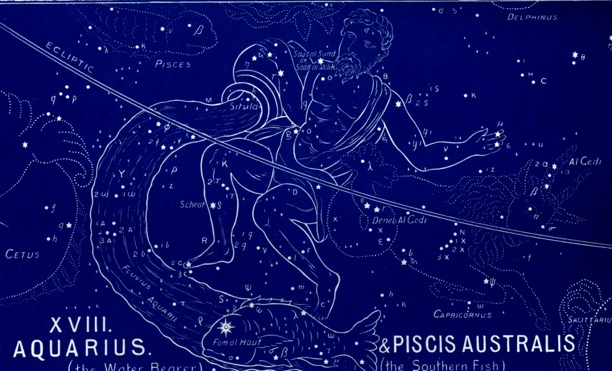
The Star Fomalhaut is located in the eye/head of the Southern Fish. This aligns with mental ability. The color that is associated with this Direction may vary: it can be blue, representing water. As we view the colors of the Hebrew Tabernacle, their scriptural basis provides a solid foundation of God’s Word to draw our conclusions from, avoiding speculation and private interpretation.
Each of those four tribes is linked with one of the royal constellations in the blessing given them by Jacob or Moses. Reuben was told he is “unstable as water,” alluding to the Water Bearer. The name Reuben, means “Behold a son,” also ties him to the Water Bearer, among the zodiac signs, having the figure of a man. He is also mentioned as being over the “excellency of power” (Gen. 49:3-4), as Reuben aligned to the winter season in the original prophetic calendar, [Deut. 33:6].
The tribe of Judah was given the prime position in this Zodiacal design by being located directly east of the entrances to the Tabernacle and the later Temples. The positions of these four prime tribes were arranged 90 degrees from each other within the 360 degree circle– to accord with the four seasons of the year, and the cardinal points of the compass. As a key aspect of the Gospel in the Stars a prophetic account centering on the Messiah and Promised Seed of Israel destined to come from the tribe of Judah, each of the 12 signs told a critical aspect of the Messiah’s deliverance of Israel, as the chief tribe Judah/Leo– was set to preside over the summer season in prophetic and the calendar matters, [Deut. 33: 7].
Figure 4. Leo The Lion of Judah. #12

“Judah is a lion’s whelp” (Gen. 49:9) ties him to the Lion. Moreover, John refers to Christ as “the lion of the tribe of Judah” (Rev. 5:5), establishing the linkage of Judah to the lion. The Lion represents the King, and Judah began the royal lineage through which the Davidic line of kings came. The name Judah means “praised,” suggesting that this line of kings in the Christ-Line through him (especially Christ) would be praised.
The next pivotal tribe proceeding counterclockwise around this zodiacal design of the “Camp of Israel“… was Dan. It was positioned on the north side of the Temple and Jerusalem as a venomous animal, sometimes displayed as an eagle with a snake in its talons, called Scorpio, a venomous scorpion today. Its station was at the autumn season in the prophetic calendar of Israel.
“Dan shall be a serpent…that bites the horse heels” (Gen. 49:17), which parallels the symbolism of the Scorpius/Serpent, depicted stinging the Serpent Bearer-Ophiuchus in the heel, [Gen. 3:15] The name Dan means “judge” and the serpent symbolizes the wisdom of a judge. The serpent in Eden was acknowledged as one of the wisest of his creatures. For example, the Lord has admonished his servants to be “wise as serpents and harmless as doves.” The kind of wisdom referred to especially invokes that of being a good judge. Antares, the bright star in the Scorpion’s heart, is realized as the seat of wisdom. For example, the Lord put wisdom into the heart of King Solomon so that he could judge his people wisely, (2 Chron. 1:11-12, 1 Kings 10:24; cp, Ex. 26:2, Ecc. 8:5, Job 38:36).
Figure 5. Taurus the Bull From Jamieson #13
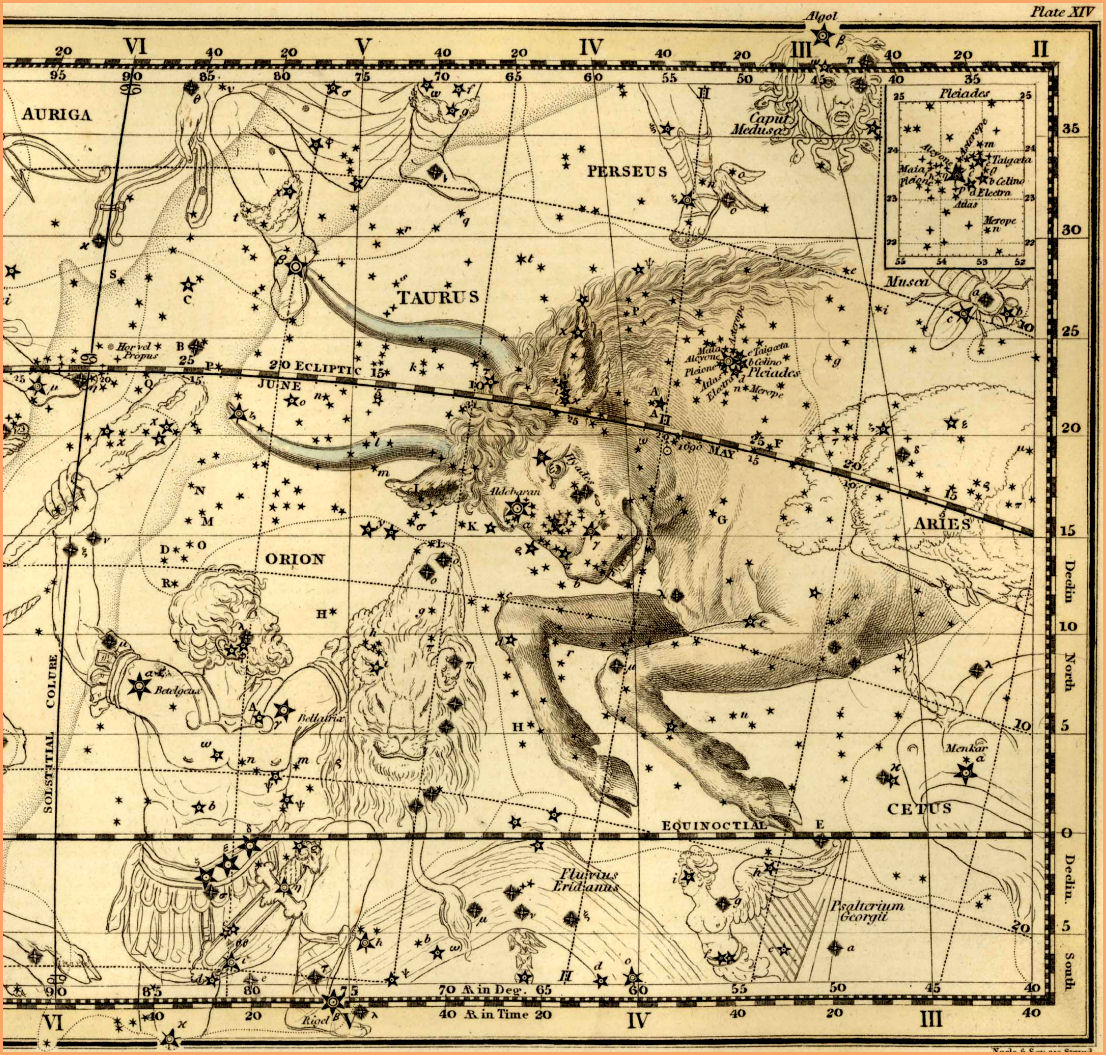
Finally, Joseph is compared to a wild ox, with Joseph’s son’s Ephraim and Manasseh compared to its two horns (Deut. 33:17). The Hebrew word refers to an extinct species of wild ox the size of an elephant having two long forward pointing horns, seen in the sign of Taurus the Bull. The bright star Aldebaran in Taurus represents its eye, the symbol of a seer (one who “sees”). Joseph was a great seer, so the Bull was appropriate for his sign. The name Joseph means “Jehovah has added,” probably referring to his multitude of descendants, in Ephraim and Manasseh, the horns of this sign. Ephraim was on the south side of the Temple and Jerusalem as the bullock of Taurus, positioned to align to the spring season in the context of its prophetic and calendar implications.
Thus, each of the four principal tribes of Israel are explicitly correlated in the blessings of Jacob, to one of the four cornerstone constellations at the cardinal points.
iv. Banners and Directions. Each of 12 tribes of Israel had a flag or banner with its sign. The Hebrew word for “sign” is translated “ensign” in the KJV Bible (Num. 2:2), but Hebrew scholars make it clear that the signs also refer to zodiac constellations. According to tradition, the figure of a man was found on Reuben’s banner, a lion on Judah’s, a serpent on Dan’s, and a bull on Joseph’s (Son’ Ephraim, who took his place). These were the same images seen on the tribal flags in their wilderness camp, reflecting the four banners facing the four cardinal directions: Judah facing East, Reuben facing South, Ephraim facing West, and Dan facing North, with the Scorpion replaced by the Eagle.
(Num, 2:3,10,18,25). Below the High Priest [Christ] is seen in the center vesica, with these four cardinal constellations at the corners of this engraving.
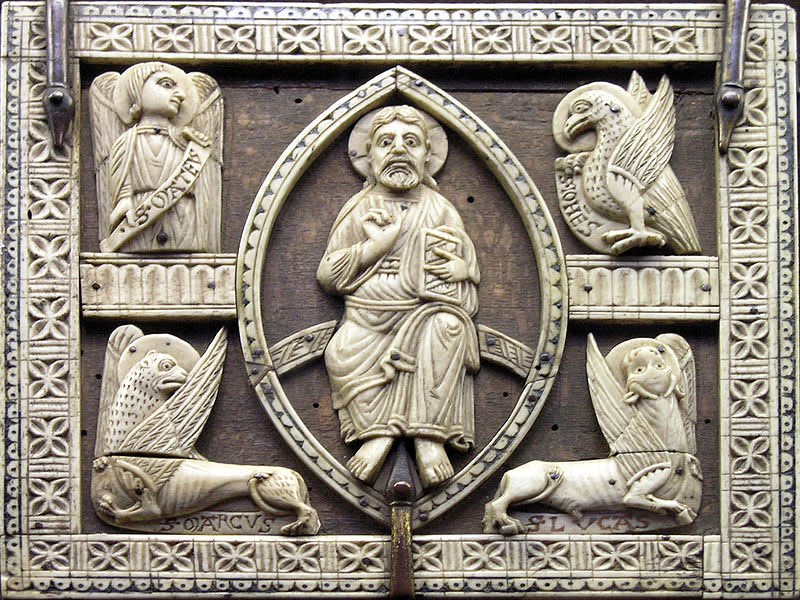
The ancient Greeks described Taurus as a snow-white bull. Aldebaran, a first magnitude star is located at the eye of the Bull, the eye-symbolic of a seer, as was Joseph of Egypt, associated with the Bull. Thus, the Bull is symbolic of spiritual strength, and especially the gift ministry of being a Prophet/Seer.
Blue is symbolic of peaceful tranquility, that goes with the wisdom of a good judge. When applied with a gift ministry it is the wisdom that is from above, which is first pure, peaceable and gentle, easy to be entreated, full of mercy and good fruits [Gal. 5:22] as part of the fruits of righteousness, sown in Peace of them that make peace. This is how we can emulate the Prince of Peace, to promote true and genuine peace and Justice.
Antares is located at the heart of the Scorpion. The heart is a figurative seat of wisdom, and the scorpion/serpent symbolizes wisdom. The heart/chest-the regulator/pump of the body’s life-blood can also symbolize emotional/ and physical/ strength.
Thus, the placement of all four of the royal stars in the cornerstone signs is consistent with the symbolism of emotional, spiritual, mental and physical aspects of all living souls. Note also that spiritual and physical aspects are opposite each other in the circle (white opposite purple), as are the mental and emotional (blue opposite red), also found in the Yin/Yang symbol.

In Num. 10:14-28, God’s Word removes the mystery of the order of the 12 tribes as they camped in the wilderness. Num. 11:14 verifies that the Standard [H1714–degel; flag, banner] of Judah/Leo in first place, followed by Issachar in v. 15, and Zebulon in v. 16, with the sons of Gershom and Merari, Levites bearing the Tabernacle. Next was the Standard of Reuben’s tribe in v. 18; followed by Simeon in v. 19, and Gad in v. 20, with the Kohathites bearing the Sanctuary in v. 21, to sum up the first 6 tribes. The Standard of the Camp of Ephraim is listed in v. 22, with Manasseh next in v. 23, as Taurus’ two horns, then Benjamin, in v. 24. Verse 25 shows the Standard of Dan as the rearward of all the camps and their hosts, followed by Asher in v. 26, and Naphtali in v. 27. Verse 28 concludes with;
28 Thus were the journeyings of the children of Israel according to their armies, when they set forward.
Figure 6. the 12 tribes in their wilderness Camp around the Tabernacle. #14

From a Bible perspective outside the books of Genesis and Job, God revealed His Word and Will to the Patriarchs in the stellar witness and Celestial Gospel of the Promised redeemer of mankind. When we consider the Hebrew word “mazzaroth,” we find an early reference to the 12 Mazzaroth signs, occurring as a unit in Job. Later references to the 12 signs of the ecliptic in Scripture, are built upon what we find here in Job and the Genesis Creation record and the Patriarchs. This provides added evidence of the antiquity of this knowledge of the entire zodiac, in the context of the Bible Patriarchs. In the graphic above we find the 12 Tribes of Israel linked to the order of the 12 Mazzaroth signs, with 3 tribes camped on each side, 4-square and the Tabernacle in the center, with Moses, Aaron and the Priests in the middle inside the square of 12 tribes.
This order of the 12 tribes as they camped around the Tabernacle is established in Numbers 2 in a graphic in the marginal notes of The Companion Bible by E.W. Bullinger, related to Num. 2:32.#15 Bullinger also has marginal notes on Num. 2:2 related to the word ‘standard‘ [H1714–degel; translated ‘ensign‘ as follows; “each standard is said to have its “sign” [H226–owth; sign, token, symbol, standard, prodigy, miracle, indicating a signal of something, as God’s Abrahamic Covenant had circumcision, [Gen. 17:11].#16 A foundational aspect of God’s Word is seen in Gen. 1:14;
14 And God said, Let there be lights in the firmament of the heaven to divide the day from the night; and let them be for signs, and for seasons, and for days, and years:
These ‘signs‘ are specifically related to the stellar nature of the 12 signs of the ecliptic, as seen in Gen. 37:9 linked with the 12 tribes of Israel fulfilled in the 11 brothers of the Patriarch Joseph. As we search the details of The Celestial Gospel, we will find it specifically and clearly stated in God’s Word, as part of God’s Old Covenants with His chosen people, especially in Abraham’s Covenant.
As Gen. 2:19-20 states:
19 And out of the ground the Lord God formed every beast of the field, and every fowl of the air, and brought them unto Adam to see what he would call them; and whatsoever Adam called every living creature, that was the name thereof.
20 And Adam gave names to all cattle, and to the fowl of the air, and to every beast of the field; but for Adam there was not found a helper meet for him. [KJ21]
In v.19 what Adam would “call” the beasts of the field, and whatever he “called them“ is the same Hebrew word [H7121-Qara] as in v.20 where Adam names every beast of the field. Strong’s says Qara means “to cry out, to call aloud, to roar, proclaim, pronounce or preach, to summon, invite, call together, to appoint, praise, celebrate, or call by name.” Its basic meaning is to enunciate a specific message addressed to a specific recipient, to elicit a specific response. The verb form of this word is used in the act of naming, that sometimes is an assertion of sovereignty over the thing being named; [Gen. 1:5, Ps. 147:4, Isa. 40:26]#17
Even as God-the Father of lights asserts His authority and sovereignty over the division of Day and Night in Gen. 1:5, and over the naming of the stars in Ps. 147:4, so Adam asserted his sovereignty over the Animal Kingdoms of life, delegated to him by God.
We should note that Adam’s delegated sovereignty pertained to Earthly things, while God’s sovereignty ruled over all, with special emphasis on the things of the Heavenly Creation, as they shed their 3-fold light upon the Earth. When God calls the roll up yonder for the stars, they are present and accounted for in His summons, to fulfill the reason and purpose He called and created them. The named Stars fulfill their part to proclaim the Celestial Gospel in witnessing to the Coming Christ! This word [Qara] is also found in reference to the Seed of Abraham, namely Isaac, [Gen. 21:12b] “for in Isaac shall thy seed be called.”
Genesis 1:14-16
And God said, Let there be lights in the firmament of the heaven to divide the day from the night; and let them be for signs, and for seasons, and for days, and years: [15] And let them be for lights in the firmament of the heaven to give light upon the earth: and it was so. [16] And God made two great lights; the greater light to rule the day, and the lesser light to rule the night: He made the stars also.
Gen. 1:14: “signs“- indicate first, the significance of the work wrought, and secondly, someone significant to come.[5] In context, the “work wrought” is God’s re-ordering of creation in the 2nd Heaven and Earth, repairing the damage inflicted on the 1st Heaven and Earth as a result of Lucifer’s revolt in heaven, causing it to be “without form & void.” [Gen. 1:1, Rev. 12:1ff] God’s repair job is divided into 7 spiritual administrations, or dispensations, each one bringing man’s relationship with his Creator back into increasing harmony, [Heb. 11:3]. This repair narrative is found in God’s progressive Covenants with Man, with each step bringing man closer to that perfect fellowship in Original Paradise with the Creator restored.
It also refers to the celestial narrative that “someone is coming,” the redeemer, the promised seed who is Jesus Christ. He is the central figure and subject of God’s Word. He is the one that the 12 Mazzaroth signs prophesy, the one embodying the light of the world, who fulfilled all Old Testament Law, and personifies the spiritual illumination of the world. The earth was thrown into Chaos between Gen. 1:1 & 1:2, but the effulgence of this light, the Sonrise of the ages, was framed between the two great lights of the Sun and the Moon on his birthday, precisely in the star Spica also called Al Zimach in Arabic (tsemach in Hebrew) in Virgo, on Tishri 1, 3 BC. Jesus’ birthday on New Year’s Day of the Hebrew calendar, celebrates the anniversary of Creation, revitalizing the social and spiritual structure of Israel according to the ruling Standard and scepter of the King of Kings. God had this date preserved in His omniscient foreknowledge before the Creation, instituted in the Hebrew Calendar, uniquely marked by the stars included in the story of Bethlehem on this date in 3 BC. We also find the pattern of the four points of the compass in star and planet signs marking the birth of Christ.
The pattern of eastern access to the Temple and Tabernacle is established in the order of the celestial signs surrounding the birth of Christ. We find this in the pattern of the 3 Jupiter-Venus Conjunctions, marking Christ’s birth that occurred from 3 to 1 BC. The first Conjunction was in the final degree of Cancer, near its zero line border with Leo. The second was fully in Leo, while the third was in Virgo. These three signs represent the eastern quarter of the zodiac of Israel, the heavenly image of the eastern side of the wilderness camp of the Israelites, the entrance or Way to the Door of the holy place (the truth) in the Hebrew Tabernacle. In Genesis 3:24, after God rejected Adam and Eve from Paradise, He protected the Way of the Tree of Life on the east of Eden, with the Cherubim’s fiery sword, until the redeemer could come to reactivate the way of salvation and eternal life with God, for humanity. This door ultimately led to the altar of the holy of holies, (the Life)-the inner heart of God’s temple-Sanctum, holding the Ark of the Covenant. The temporal progression of 3 Venus planetary unions perfectly matched the divine pattern of Israel’s tribal order on the east side of the Tabernacle. Judah/Leo was due east of the entrance to the holy of the holies, via the holy place, centrally located between the other two eastern tribes of Issachar/Cancer and Zebulon/Virgo. This eastern door to the Tabernacle represents the way, the truth, and the life, of John 14:6, embodied in Jesus Christ as light of the world, and the door of the sheep, as OT Shepherds slept across the door to their penned flocks, guarding the sheep with their lives, blocking the opening in the fold-walls. A Good Shepherd– is seen in the decan Auriga [Jn.10:9-17]. A Great Shepherd [Heb. 13:20, 1Pet. 2:25] & Chief Shepherd in [1Pet. 5:4] true way that leads unto life. [See also Jer. 23, 25:32-38, Ezek. 34]
Numbers 27:16-17
The Shepherd is the most popular metaphor for Bible leadership, but also we see that God chose actual shepherds for many of the primary roles of leadership over Israel. For example, Moses and King David, are two most prominent paradigms of leadership in all of Scripture, both started out as shepherds. And of course, Ps. 23:1-a most popular Bible verse, God Himself is compared to a shepherd.
The word for “lights” in the firmament [Gen. 1:14, 16 “maor“]18 is the same word used in reference to the lamps of the Menorah, (Exodus 20:27, 35:14). This word shares the same root of the word used for “light” in [Gen. 1:3-4], that God divided from the darkness, setting the universal standards of Day and Night. It should be noted that the Day was divided from the Night, and the light from darkness prior to the creation of the Sun and Moon. This points to spiritual light vs. dark
[Jn. 1:5], as the reason that the Earth became without form and void, between Gen. 1:1-2. The pure Light perfection of the Almighty in perfect righteousness removes any possibility that God created the universe in Chaos, thus the context of Lucifer’s failed insurrection against the Almighty, is the reason the earth was thrown into chaos. Also, the foundational order of Creation seen in God’s order or command to divide the light from the chaotic darkness, was a response to the enemy in his overthrow of God’s original order in the First Heavens and Earth, precedes God’s re–organization of this light in the Second Heavens and Earth, during the “Genesis Creation week.” The verses above also exhibit how the Sun, Moon and Stars regulate seasons, days and years, in God’s created temporal order.
The Celestial Gospel was always to be based on the long-view of Biblical history of God’s Covenants with man, as they progressively bring man closer to the state of Adam’s original fellowship with God, which God never explained to Adam or any other Bible Patriarch. God’s monumental job of restoring Creation is being set and accomplished by bringing humanity back into a state of spiritual redemption so man can fellowship with God as Adam and Eve did in Original Paradise. God started His dialogue of dividing Day from Night and light from Darkness before He created the Sun and Moon and stars, as the lights in the sky, referenced in His Covenant of Day and Night that began in Gen. 1:3-5, was upheld in Gen. 8:22, and ends in Rev. 21:23-25. This excludes Faulkner’s assertion that God revealed to Adam the details of His foreknowledge regarding the entire Plan of Redemption,#19 that was not included in the Celestial Gospel to begin with! Here Faulkner not only discounts God’s eternal plan and the purposes in His Covenants, but also contradicts Scripture in too many ways to count! The basis for Faulkner’s “strawman” argument against the Celestial Gospel, also ignores the truth that God kept the Great Mystery a secret which excluded it from the Celestial Gospel, as part of His master-plan of Redemption, [I Cor. 2: 7-10, Rom. 16:25-26].
A precept of this study documents how in truth, the Celestial Gospel is clearly and specifically stated in God’s Word, as part of God’s Old Covenants with His chosen people. The Hebrew word for “Covenant” [H1285-Beriyth]#20 is defined as “an agreement between nations; [Josh. 9:6], individuals and friends; [I Sam. 18:3, 23:18] or man and wife, [Mal.2:14]. A most important Covenant between God and Abraham [Gen. 15], was confirmed by Moses, [Ex. 24:7-8, 34:27, Deut. 5:2], was renewed and amended, after the exile, through the intervention of the prophets; [Isa. 42:6, 49:8] and the Messiah [Mal. 3:1, cp. Jer. 31:33-37]. It was a treaty, an alliance of friendship, a pledge, an obligation between a Monarch and his subjects, a Constitution. It was a contract accompanied by signs, a solemn oath and sacrifices, that sealed the relationship with promises of blessing for obedience and curses for disobedience.”
The Celestial Gospel also documents the effectual means of Oral transmission of the Covenant tenets, not replacing their foundations in God’s perpetual Scriptural Covenants with man, but as an inseparable part of them, prior to their being recorded into the scrolls of the OT Scriptures by Moses. Man has always needed an external standard for Godly truth outside of himself, working in union with man’s inner compass and God–given conscience, that began with Adam & Eve in the Garden, before the giving of the OT Law. We will see more details of this in the record of the Abrahamic Covenant below.
Covenant Theology holds that God created humanity as one people, starting with Adam and Eve, who broke God’s only condition, not to eat of the tree of the knowledge of Good and Evil. After their fall from perfection, and rejection from Original Paradise, and with their seed in Seth, were led back to God via certain key Biblical Patriarchs with whom God made perpetual Covenants. This redemptive history, starts after the fall of Adam and Eve, as God makes firm His Covenant with Noah [Gen. 6:18] to bring him and his family into the Ark, with every living thing of all flesh, two of every sort, male and female. In Gen. 9, God established His Covenant with Noah and his seed after him [Gen. 9:9-17], with His token of the Covenant on 2 levels: with every living creature on the Ark with Noah, for perpetual generations, and with Earth itself, seen in the rainbow, not to destroy it by flood again.
Figure 1. Genesis Patriarch’s Table. 21

By adding up the age of years in the genealogies of Genesis 5 and 11 we find the number of years from the Creation of Adam to the birth of Abraham as about 2000 years. Since there is almost universal agreement that Abraham lived around 2000 B.C., we can see the Bible teaching that the human race was created near 4000 B.C. and is thus, is about 6000 years old.
Noah is a key Biblical Patriarch because he embodies the transition between the pre-flood and the post-flood world. Thus all the systems of Biblical timekeeping going back to Noah, Abraham, Isaac, Jacob & Joseph, after the flood, includes the coordination of the luni-solar year, the year divided into 12 months of 30 days, giving a 360-day year, relating to the 360 degrees of the circle, all trace back to Noah’s pre-flood days. Thus, the calendrical practices of the Patriarchs of the Bible are summarized in Noah, combining the Lunar, Solar and Sidereal years in his standards of astronomical timekeeping. Since Noah was already 600 years old when the deluge fell upon Earth [Gen. 7:6], Noah’s use of this calendar continued, up to and including the 120-year period (120 x 3= 360), wherein he built and furnished the Ark. The Ark’s construction was according to the revealed plan of God, following a consistent divine pattern, the same tripartite pattern found in the Tabernacle of Moses and the Temple of David and Solomon, based on 3 Heavens and Earth’s and 3-fold creation of man in body, soul & spirit. Noah’s Covenant basis for his 360-day calendar, is also found in God’s Covenant of Day and Night, as we will see presently.
The Genesis record of Noah establishes the advanced astronomical practices of the Biblical Patriarchs, providing a basis from which, the roots of ancient Astronomy and studies in Archaeo-Astronomy are traced to their true context. Noah’s Covenant with God took place after his family came out of the Ark, and included the first burnt offerings on the altar that Noah built, [Gen. 8:20-22]. This established an unconditional Covenant relating to the Earth, even as God’s Covenant with Abraham did, referring to Israel’s claim on the Promised Land. This is in opposition to those who would remove or ignore God’s perpetual claim on the Promised Land that He chose for His People, as the Creator of Heaven and Earth.
The accuracy of these ordinances of heaven set the standard for truth, in the key area of calendars and timekeeping also, still applied today, according to the perpetual Covenant of Day and Night [Jer. 33:20-22]. This is one trait of “heavenly mandates” that their truths can remain intact beyond the scope of their original Biblical Administration. In the record of Gen. 8 and Noah’s Flood, verse 22 certainly stands out as an ordinance of heaven that has remained a constant, governing the seasons [Gen. 1:14] after the flood. This is a key aspect of God’s Covenant with Noah, where God’s Promises are made with Noah and his seed, that day and night shall not cease.
Genesis 8:22
While the earth remains, seedtime and harvest, and cold and heat, and summer and winter, and day and night shall not cease.
This verse opens with the words; “While the earth remains,” speaking to this Covenant being Everlasting and perpetual in nature because the Earth will be around forever. The connective “and” is found 7 times in v. 22, and according to Bullinger “pairs four sets of opposites, to express the completion and perfection of this perpetual Covenant,” that shall not cease.#22 In Gen. 9, as God further established His Covenant with Noah, and his seed and every living beast on earth, with His token or sign of an everlasting Covenant, listed 7x in Gen. 9; [Gen. 9:9, 11, 12, 13, 15, 16, 17], that The Almighty established with all flesh upon the Earth. Gen. 8:22 is a key aspect of the “Rainbow Covenant” with Noah, as the productivity of the earth’s life cycles in four seasons, in the 4 Kingdoms of life, perpetuate in the 2nd Heavens and Earth, in the Covenant of day and night, [Jer. 31:31-37]. Gen. 8:22 also reflects the biblical symbolism of the number four, as the first square number mathematically, witnessed pervasively in nature, as 4 elements of earth, wind, fire, and water, four points of the compass, north, south, east and west. Also, the 4 lunar phases, mirror the 4 Cherubim angels that quarter the 12 Mazzaroth signs. There are also four heads of the animal kingdom, witnessed in the four constellations at the celestial cardinal points; Leo the Lion-King of wild beasts, Taurus the Bull and king of domesticated animals, Aquila the Eagle, king of the bird kingdom, and the Man–Aquarius of the human kingdom. There are numerous other examples of biblical symbolism in the number four, like the four-fold ministry of Christ reflected in the Four Gospels, supporting this wisdom in God’s order of Creation. #23
Footnotes for Segments 1 & 2.
1. A Further Examination of the Gospel in the Stars, Faulkner [www.Answers in Genesis.com]
2. http://philologos.org/__eb-mazzaroth/207.htm
3. IBID
4. A Further Examination of the Gospel in the Stars, Faulkner [www.Answers in Genesis.com]
5. “The Rational Almanac“, Moses Cotsworth.
6. Figure 2 picture credit. “Witness of the Stars” p.21, E.W. Bullinger
7. The Works of Josephus, 5.4 & 5.5, p. 707. translated by W. Whitson.
8. https://www.ancient-origins.net/ancient-places-europe/dating-lascaux-art-0017021
9. “Secrets of the Great Pyramid,” Peter Thompkins, refers to Archaeo-astronomy of; Sir Norman Herbert Lockyer, Schwaller de Lubicz, Livio Stechini ppg. 159-175. See Also Giorgio de Santillana & Hertha von Dechend, in “Hamlet’s Mill.”
10. Strong’s Concordance [H8403] and [H4908] & [H4720] James Strong.
11. “The Stars proclaim the Bible Message.” [Damien Mackey refers to Dr. Earnest Martin]. Also on; [http://www.rogerswebsite.com/articles/TheLostHistoryofJerusalem.pdf]
12. Figure 4. Picture credit, [http://www.redbubble.com/people/griffdesign]
13. Figure 5. picture credit from Jamieson.
14. Figure 6. picture credit, 12 tribes encamped
15. Companion Bible Image in marginal notes of Num. 2
16. Strong’s Concordance, [H1714–degel] and [[H226–owth] James Strong.
17. IBID, [H7121-Qara].
18. IBID, [H3974-maor].
19. “Universe by Design,” p. 134, Chapt. 1 FN. Dr. Danny Faulkner
20. Strong’s Concordance, [H1285-Beriyth] James Strong.
21. [www.pinterest.com]
22. E.W. Bullinger’s Companion Bible. Marginal note on Gen. 8:22.
23. “Number in Scripture.” ppg. 123-125, E.W. Bullinger

